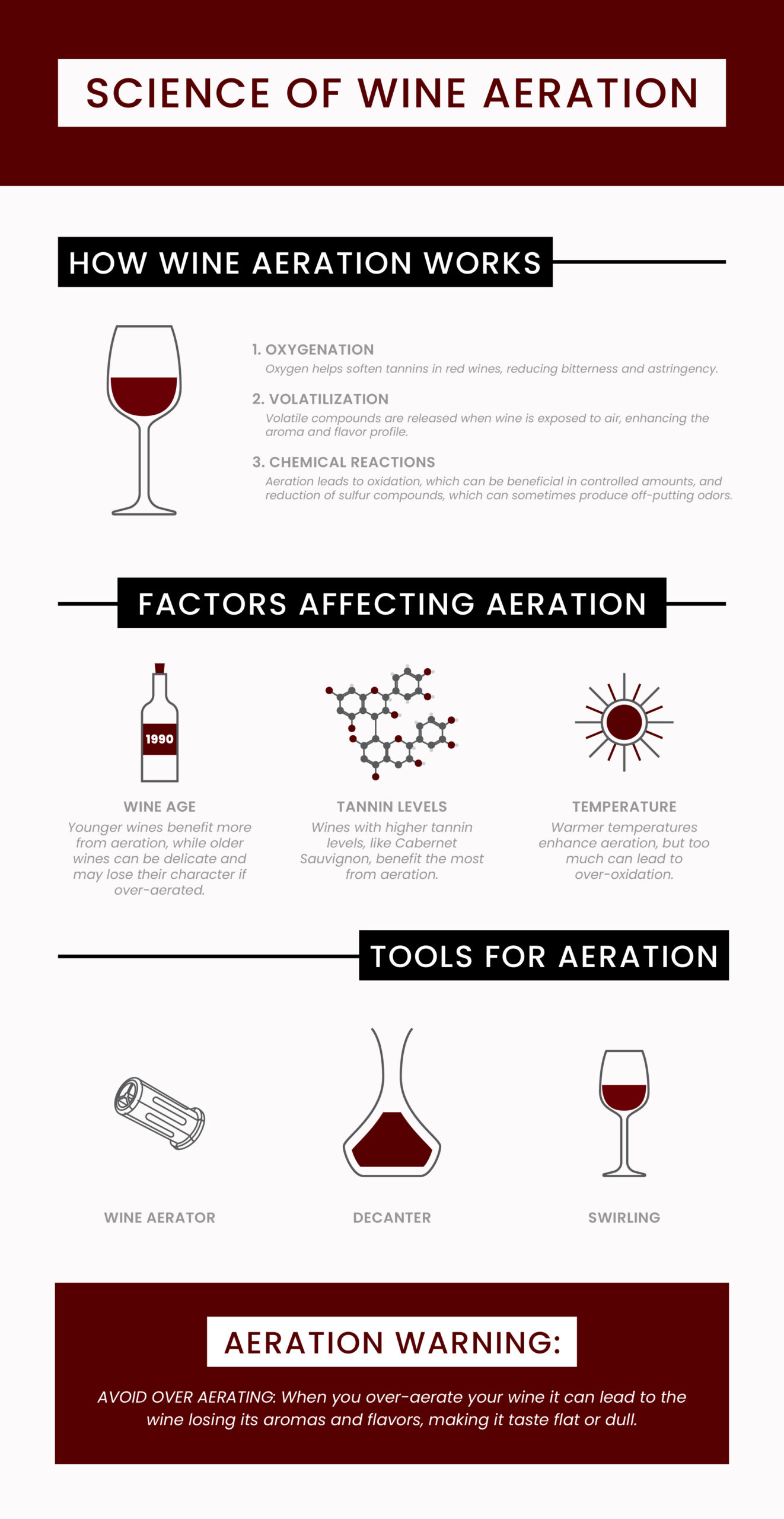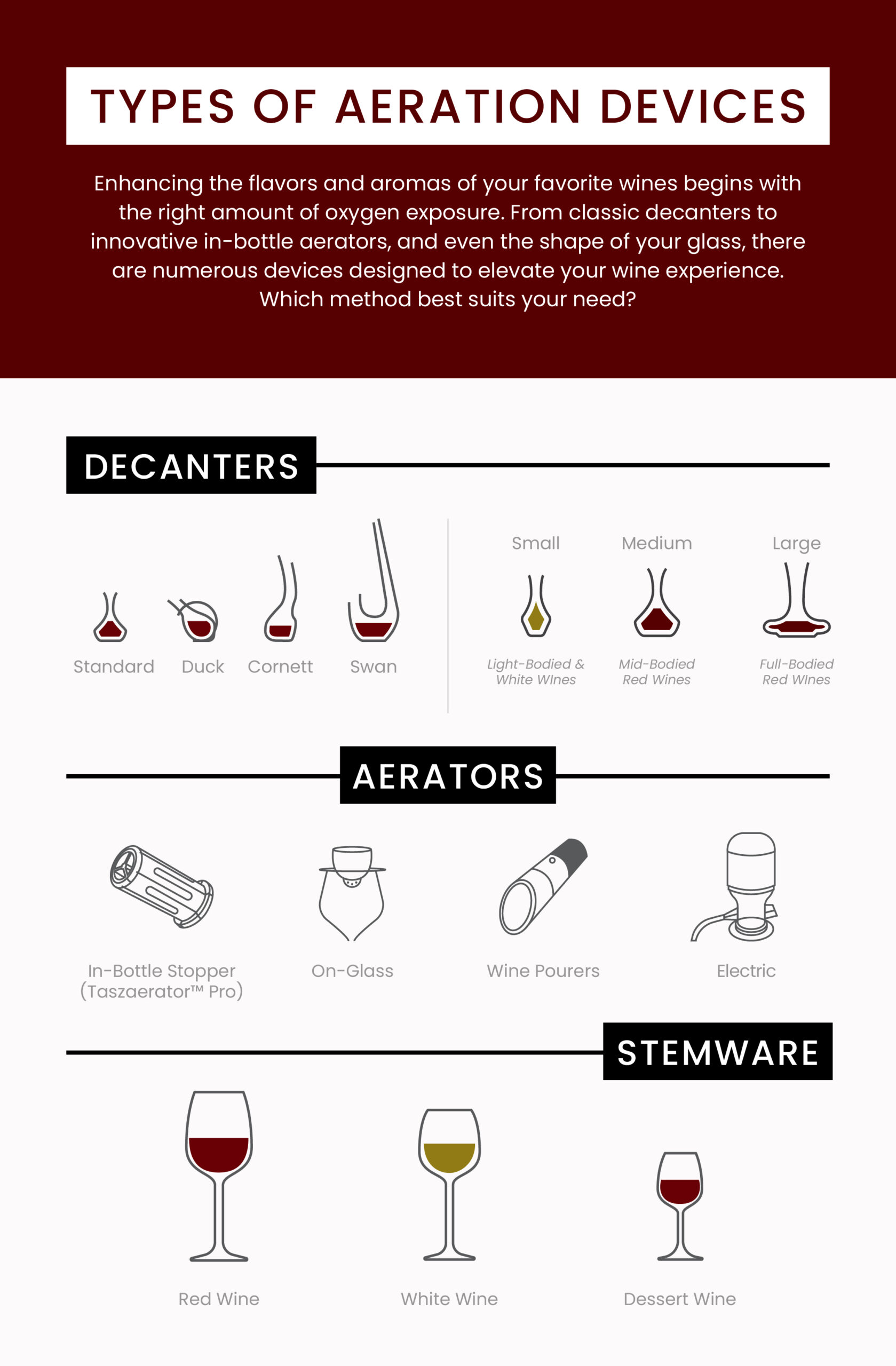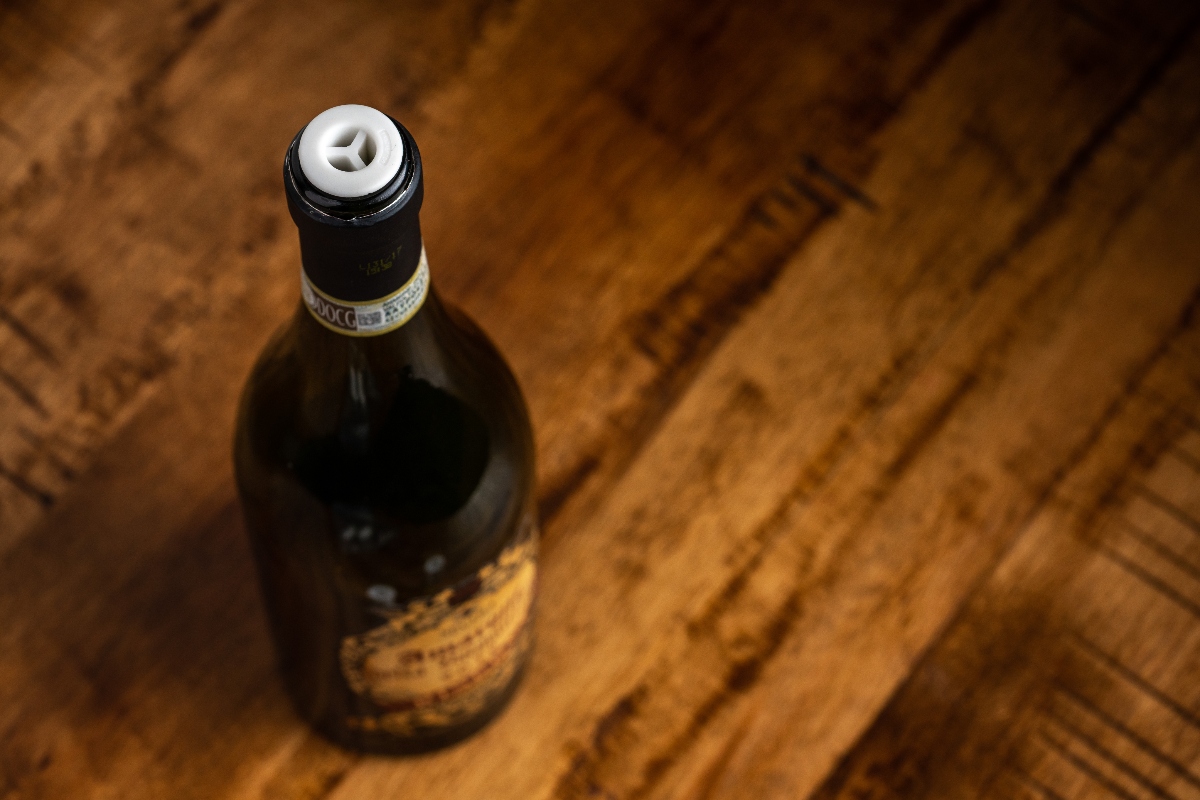- Understanding Wine Aeration
- How to Aerate Wine
- Do You Aerate White Wine?
- Does Aerating Wine Reduce a Hangover?
- What Are the Benefits of a Wine Aerator?
- When to Aerate Your Wine
- Does Aerating Cheap Wine Make It Taste Better?
- Decanting vs. Aeration
- Is It Better to Decant or Aerate Wine?
- Wine Aeration and Sulfites
- Benefits of Using a Wine Aerator
- How Hard Is It to Aerate Wine?
- Aeration Tips and Tricks
- Aerators Are Must-Have Tools for Wine Lovers
- Frequently Asked Questions
The Ultimate Guide to Wine Aeration: Everything You Need to Know

Unlocking the Secrets of Wine Aeration: Elevate Your Wine Experience
Many people open a bottle of wine, pour a glass, and start sipping. While this can produce a pleasant experience, you may have noticed more seasoned aficionados swirling the wine in their glasses, decanting it into another bottle, or popping an aerator in the top of the bottle before pouring.
These actions are all designed to aerate the wine — an essential step for preparing to enjoy some of your favorite vintages. How does aeration improve the aromas and flavors of wine, and what is the best way to do it? Here’s what you need to know before you start sipping your next glass of grapey goodness.
Understanding Wine Aeration
Many people open a bottle of wine, pour a glass, and start sipping. While this can produce a pleasant experience, you may have noticed more seasoned aficionados swirling the wine in their glasses, decanting it into another bottle, or popping an aerator in the top of the bottle before pouring.
These actions are all designed to aerate the wine — an essential step for preparing to enjoy some of your favorite vintages. How does aeration improve the aromas and flavors of wine, and what is the best way to do it? Here’s what you need to know before you start sipping your next glass of grapey goodness.
How to Aerate Wine?
Those new to the wine-drinking world may start simply enough by pouring their reds, whites, and rosés and then swirling the liquid in their glasses. Unfortunately, swirling doesn’t expose the wine to sufficient oxygen — and if you aren’t careful, it’s a recipe for spills.
You might also be intrigued by decanters, or clear glass bottles into which you pour an entire bottle of wine. These bottles do more than just offer an attractive presentation; their unique shape, with a funnel-like neck and a larger base, distributes wine over a greater surface area as you pour, offering slow, gentle aeration.
Even so, you should leave wine in the open decanter for at least 15 to 20 minutes before you drink it, and it’s best to consume all of it within a few hours of decanting. If you don’t, the oxygen exposure will cause the wine to turn faster.
An aerator offers a much more effective means of wine aeration. It not only promotes rapid oxidation that allows you to start sipping right away, but it also aerates by the glass, allowing you to reserve the rest of your bottle if you don’t end up finishing it.
Do You Aerate White Wine?
Whether to aerate white wine or not is a tricky question — the answer is “maybe.”
If you are familiar with the difference between red and white wines, you may know that reds are typically fermented from grapes with the skins left on (known as “skin contact”), while whites generally aren’t.
Skin contact imbues red wine with a bigger body — but also with more tannins, which cause a bitter flavor in the short term. This is why red wines are aged, which softens the tannins and creates a richer bouquet of aromas and flavors. Aeration helps to highlight this complexity found in red wines.
This isn’t to say you can’t aerate white wines. However, many white wines are served young (versus aged) because they have fewer tannins to begin with. This means their bouquet is fully developed. Aerating these vintages could potentially work to counteract their ideal aromas and flavors.
For this reason, you should only consider aerating heavier, more full-bodied whites. Some examples include Chenin, Burgundy, Bordeaux, and Chardonnay. These heavier whites may benefit from aeration, whereas lighter-bodied vintages will not. The same principle applies to rosés.
Does Aerating Wine Reduce a Hangover?
There’s no clear evidence that wine aeration reduces the hangover effects of drinking too much wine.
While some have suggested that components like histamines, quercetin, and tannins may contribute to headaches — and aerating wine helps to neutralize tannins — there’s no proof that these components are responsible for hangover symptoms.
Ethanol, a chemical found in alcoholic beverages, is the main culprit behind hangovers. This compound can cause dehydration and disrupt sleep. It can also act as a vasodilator, triggering migraine headaches in some people.
Aeration does not reduce the ethanol content of wine. The best cure for a hangover is still good old aspirin and plenty of hydration.
What Are the Benefits of a Wine Aerator?
Although aeration is unlikely to prevent a hangover, there are many advantages to wine aeration. For starters, you can drink your aerated wine immediately after pouring it and enjoy a superior bouquet.
You can expect an effective and consistent outcome when you use an aerator as opposed to methods like swirling. Wine aerators are available in a range of models and price points, ensuring every wine connoisseur can find the perfect tool for their needs and preferences.
Most aerators are also compact and easy to use. Just place them in the top of the bottle after popping the cork and start pouring. When you’re done, pull out the aerator and wash it in warm, soapy water. The small size of some aerators makes them incredibly portable and as easy to store as a wine stopper.
When to Aerate Your Wine
Wine aeration can make the difference between a truly spectacular tasting experience and one that’s just so-so or even disappointing, but you have to know when to do it.
As mentioned above, reds tend to be ideal candidates for aeration, while whites and rosés are more questionable. Should you aerate every bottle of red you drink, though? You might be surprised to learn the answer is no.
While aeration can help to open the bouquet of many red wines, particularly medium- and full-bodied vintages, the point is to neutralize lingering tannins and develop the full complexity of aromas and flavors.
However, this may not be necessary with older wines. The longer the wine ages, the mellower it becomes and the more the bouquet develops on its own. When an aged wine is fully mature, introducing too much oxygen could trample these delicate aromas and flavors.
Does Aerating Cheap Wine Make It Taste Better?
The beauty of aeration is that the effects aren’t dependent on the price of the wine. An aerator can work just as well on a $15 bottle of wine as a $50 bottle, partly because price isn’t always an indicator of quality. Like other consumables, wine prices are generally determined by the prestige of the label.
Still, it isn’t unusual for cheaper bottles to be younger wines, with pricing reflecting shorter production schedules. These wines may have a higher concentration of tannins, resulting in a pour that’s somewhat astringent. Aerating will certainly help to minimize this unwanted flavor profile and bring out the more complex fruit and terroir.
Decanting vs. Aeration
Wine aeration and decanting essentially accomplish the same goal in that they expose the liquid to oxygen to create a chemical reaction that unleashes the full complexity of flavors and aromas. Using an aerator is the most efficient and immediate way to decant wine and is thus preferred by those who want to enjoy a glass right after opening a bottle.
However, there are certain times when decanting may be preferable, primarily when it comes to older vintages. The gentler aeration of a decanter helps maintain the delicate bouquet of a mature wine. In addition, decanters are designed to help separate sediment that can build up as wines age.
Is It Better to Decant or Aerate Wine?
There are no hard and fast rules for choosing between an aerator and a decanter. For example, experts haven’t decided on a set number of years a wine must be aged to make a decanter preferable. But generally speaking, a decanter may be best for a wine aged for 15 years or longer.
The best way to decide which method to use may be to take a small sip of the wine and think about whether there are still some tannins that you’d like to smooth out or whether the wine is already mellow and drinkable when you pop the cork.
You can also look for sediment in the neck of a bottle stored horizontally on a rack. Darker glass colors can make this method difficult, though.
Wine Aeration and Sulfites
Sulfites are a natural byproduct of the fermentation process. They may also be added to wine to preserve its color and flavor and protect against premature oxidation. Some people have adverse reactions to sulfites, such as headaches and indigestion, while others do not react at all.
Unfortunately, sulfites cannot easily be removed from wine. Wine aeration does speed the process of oxygenation, which may somewhat dissipate sulfites and any undesirable aromas or flavors they can introduce to the palate. One option for reducing sulfites is a wine purifier, but even these gadgets are unlikely to remove all sulfites.
Benefits of Using a Wine Aerator
The primary benefit of using an aerator is that it enhances the aromas, flavors, and even the texture of wine. The fact that you can enjoy these benefits immediately after opening your wine and pouring a glass is a major bonus.
How Hard Is It to Aerate Wine?
There are all kinds of fancy aeration devices on the market that will cost you a pretty penny, but at their heart, they all work by exposing the liquid to oxygen.
The Taszaerator® is compact, portable, and easy to use, clean, and store, making wine aeration a cinch. All you have to do is place the aerator in the top of an open bottle and pour.
Aeration Tips and Tricks
While this guide is enough to get you started with aerating your favorite wine, keep a few tips in mind:
- More Tannins, More Aeration: One of the main purposes of aeration is to neutralize tannins — therefore, the more tannins the wine has, the more it will need to aerate
- Take Care With Old Wines: Aerated older wines may become hyper oxidized, which can make the wine lose its best qualities
- Avoid Aeration Hacks: Many people attempt to aerate wine with a milk frother, but this can damage the protein chains in the wine
Aerators Are Must-Have Tools for Wine Lovers
If you want to fully enjoy the complex body of a wine, you can use an aerator to enhance its inherent flavors and aromas without simply waiting for the liquid to breathe. Aeration is ideal for reds and full-bodied white wines, but it should be avoided with lighter whites and mellow, aged reds.
Skipping wine aeration doesn’t mean you won’t enjoy your bottle, but using an aerator offers the preferred means of experiencing the best that many of your favorite vintages have to offer.







